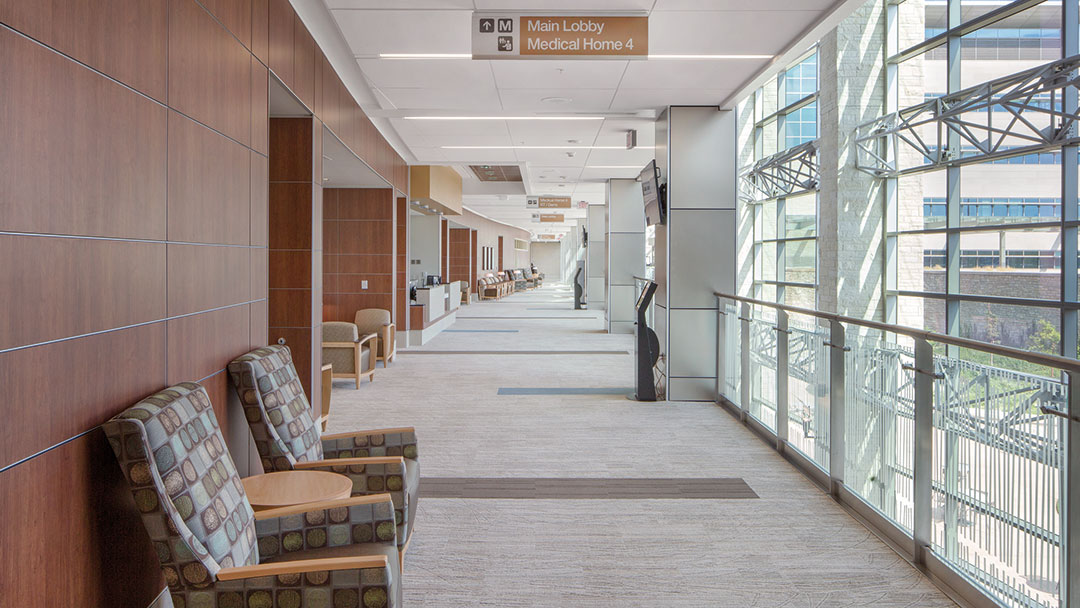Recent Articles
Facing a tough ambulatory care project? LEO A DALY is up to the task
With more than 26 CBOCs and Multiple Medical Home Projects in our Portfolio, We Translate that Experience to Private Clinics
by Leslie M. Saunders, Sr., AIA, ACHA, LEED AP
Vice President, Market Sector Leader – Healthcare
A fundamental shift has slowly been occurring in healthcare in the United States over the past four decades. A physician’s focus used to be on “fixing” patients who have ailments. But more and more, a doctor’s focus is on getting patients well and continuing to keep them well. In other words, we are moving toward population health management versus episodic treatment.
This shift has been impacting both the way medical facilities are being used and the way healthcare architects are designing them. Some serious adopters of this line of thinking include leaders in military and veteran healthcare – two of LEO A DALY’s longest-term, repeat clients. The Department of Defense (DoD) and the Veterans Health Administration (VHA) have been focused on ambulatory care facilities.
DoD’s Medical Home Model
The population the DoD manages includes active-duty troops and their families, trainees and families, retirees and families and the civilian workforce that form an installation. The new Irwin Army Community Hospital we designed in Fort Riley, Kansas, is a perfect example of the DoD’s shift in care. It features a small hospital (44 beds) with a massive clinic attached (289,000 SF).
Completed in late 2016, the ambulatory care wing is a vertical stack of identical clinic pods, set in a user-friendly, on-stage-off-stage arrangement. Public circulation is routed to the outside edge of the clinic wing, where balconies overlook a four-story glass curtain wall and a healing garden.
The pods use a layout based on the Army’s Patient-Centered Medical Home (PCMH) model, aligning providers and support staff into teams that approach care collaboratively. This gives patients a one-stop care team experience and minimum exposure to the commotion of clinic operations.
VHA’s Patient Access Care Team Model
The VHA provides ambulatory care in the patient-aligned care team (PACT) model. Each clinic is envisioned as a collection of disparate medical professionals who, together, care for a patient. The care team can include a primary care physician, nutritionists, psychiatrists, therapists, etc. — anyone who will have the ability to diagnose and treat the patient.
In the VHA’s template for these community-based outpatient clinics, or CBOCs, spaces are designed within the clinic to house all medical professionals in a collaborative environment to work with a patient. We have experience with 26 CBOCs across the country, from Hinesville and Savannah, Georgia, to Phoenix to Chula Vista, California.
Sharing the Best of Federal Design with Private Practice
Our healthcare specialists have successfully taken the CBOC model and applied it to the private sector, and on fast-track schedules. We designed a site-adapt prototype for Nebraska Medicine Primary Care Clinics in the Omaha, Nebraska, metropolitan area. Each facility provides healthcare access to the community as a stand-alone clinic using the PACT model as the main design strategy.
For the first completed Nebraska Medicine clinic, our multi-disciplinary team worked within a compressed, four-month schedule from concept through completion of contract documents. The long-standing, positive relationship between the contractor and LEO A DALY carried over into the construction phase, as everyone remained focused on the goal to keep the project on-budget and on-schedule. This was made possible through close coordination efforts between the contractor’s project manager and superintendent and LEO A DALY discipline leads, as well as working through submittals, shop drawings and clarifications quickly and efficiently.
Tight Spaces, Multiple Stakeholders
In addition to tight schedules, we’re adept at designing healthcare facilities in tight spaces with a great deal of coordination needed between many stakeholders.
The new CHI Health Creighton University Medical Center Bergan Mercy merges Creighton University Medical Center with CHI Health Bergan Mercy Medical Center. The $140 million project moved trauma functions and academic medical center operations from near downtown Omaha to an existing, more centrally located site. The effort also involved the design of a new 138,500-SF ambulatory clinic, as well as 263,200 SF of complex hospital renovations.
The clinic was built over a parking lot and is connected to an existing garage and part of the existing facility. Access was the greatest challenge. There was an assumed shared floor level among the three structures, but in reality they were slightly off. Our design team worked directly with the contractor in the field to ensure that the differences in floor levels were imperceptible.
The renovation and expansion of the emergency department was an even tighter fit. We designed a four-bay ambulance garage, along with a helipad at grade level and expanded patient parking, situated between the ED and a city street. The helipad was required for the facility to become a level 1 trauma center. We helped the client with special permits that were amended to allow helicopters to land at this location on the property.
Additionally, all residents and businesses within 300 feet were notified about the new helipad. In conjunction with the client and the city, our team held informational meetings with neighbors to alleviate their concerns.
We Listen Intently to What You Need
Our design process involves truly listening to clients to understand what they are trying to do, and then creating an environment that supports that goal. I’ve always jokingly told my team members, “if I ever hear you ask a client what they want, I’ll fire you on the spot.” Instead, we ask clients what they want to do in their new facilities, and what they need to do it. By intently listening to them, we create an environment that supports their work.
The best example I have of this approach is from the grand opening of the cardiac center at Memorial Health in Savannah, Georgia, for which I led the design. The head nurse hugged me and said, “thank you for not giving me what I asked for! You listened to what we were trying to accomplish and gave us something better.”
 About the Author
About the Author
Les leads our Atlanta healthcare team with a focus on consensus-driven planning and a commitment to each client’s needs, budget, design and schedule. He has worked on award-winning healthcare facilities for over 300 clients in 32 states and on five continents. Les has spoken extensively around the country on various topics in healthcare and campus planning and has contributed to numerous publications. With five years as the director of capital planning for a major academic and research institution, he is exceptionally qualified to perceive problems and solutions from the viewpoints of both the designer and the owner. You can call Les at 404.885.7924 or email him at lmsaunders@leoadaly.com.

